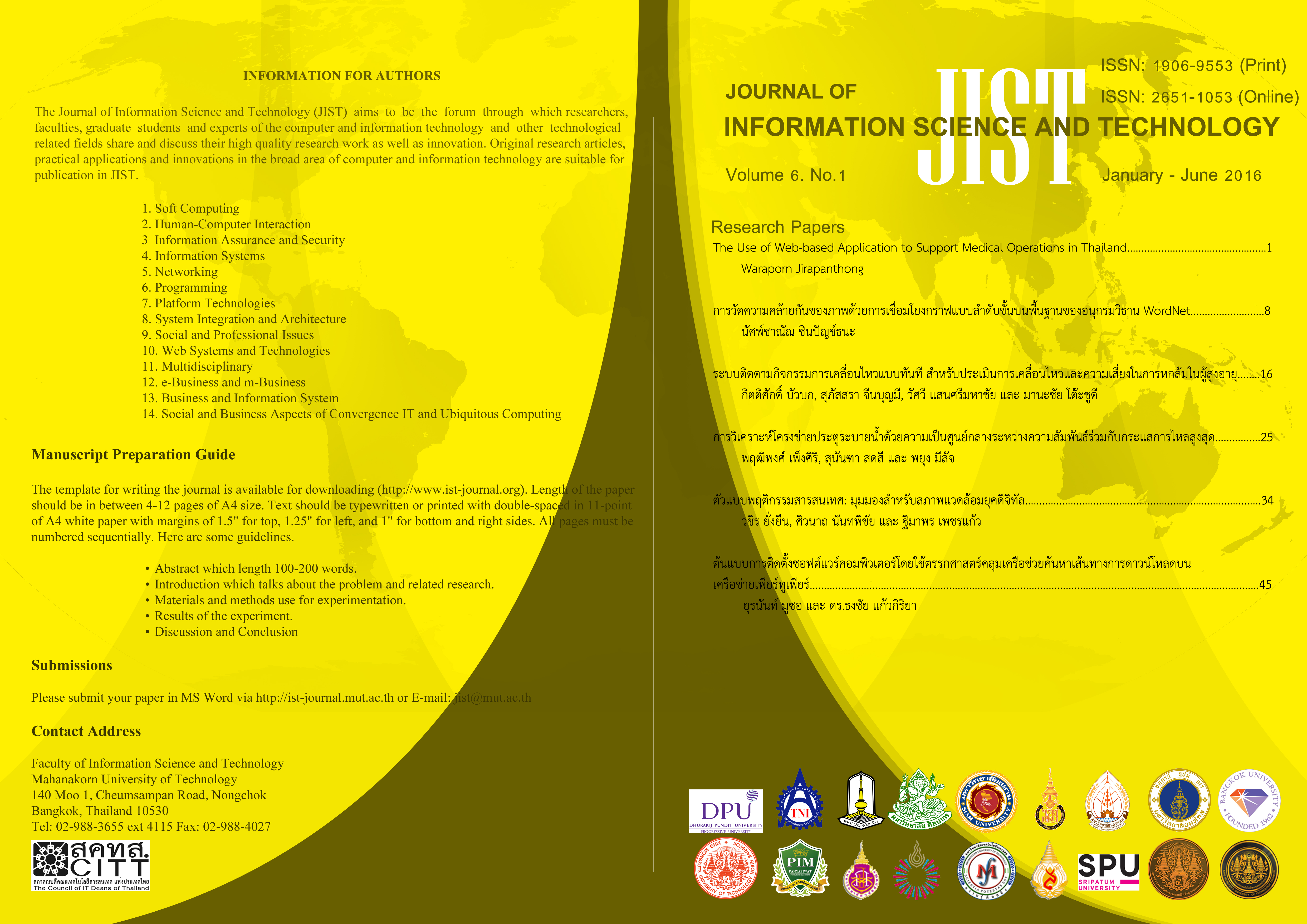The Analysis of Floodgate Network Based on A Combination of Betweenness Centrality and Maximum Flow
Main Article Content
Abstract
- This paper proposes an analysis of floodgate network based on a combination of Betweenness Centrality and Maximum Flow approach, which is called "BC-Max". It applies the theory of graph to measure the Betweenness Centrality (BC) on each floodgate in order to identify a route of drain water from source to sink floodgates. Herein, the BC is also used for calculating Maximum Flow values assigned as a draining water performance in each floodgate. In this work, the proposed work, BC-Max presents a route and a maximum flow of water draining by considering BC-Max value. The BC-Max of selected floodgate must be greater than an average BC value. The BC-Max is evaluated on a floodgate network of Southen Pasak Operation and Maintenance Project. The results shown that the average BC of this network was 0.043. As well as, the most important floodgate was Phra Mahindra and its BC-Max value was 0.787. Finally, efficient 9 routes of water draining were presented with an average of maximum flow value 24.333 m3/s.
Article Details
This work is licensed under a Creative Commons Attribution-NonCommercial-NoDerivatives 4.0 International License.
I/we certify that I/we have participated sufficiently in the intellectual content, conception and design of this work or the analysis and interpretation of the data (when applicable), as well as the writing of the manuscript, to take public responsibility for it and have agreed to have my/our name listed as a contributor. I/we believe the manuscript represents valid work. Neither this manuscript nor one with substantially similar content under my/our authorship has been published or is being considered for publication elsewhere, except as described in the covering letter. I/we certify that all the data collected during the study is presented in this manuscript and no data from the study has been or will be published separately. I/we attest that, if requested by the editors, I/we will provide the data/information or will cooperate fully in obtaining and providing the data/information on which the manuscript is based, for examination by the editors or their assignees. Financial interests, direct or indirect, that exist or may be perceived to exist for individual contributors in connection with the content of this paper have been disclosed in the cover letter. Sources of outside support of the project are named in the cover letter.
I/We hereby transfer(s), assign(s), or otherwise convey(s) all copyright ownership, including any and all rights incidental thereto, exclusively to the Journal, in the event that such work is published by the Journal. The Journal shall own the work, including 1) copyright; 2) the right to grant permission to republish the article in whole or in part, with or without fee; 3) the right to produce preprints or reprints and translate into languages other than English for sale or free distribution; and 4) the right to republish the work in a collection of articles in any other mechanical or electronic format.
We give the rights to the corresponding author to make necessary changes as per the request of the journal, do the rest of the correspondence on our behalf and he/she will act as the guarantor for the manuscript on our behalf.
All persons who have made substantial contributions to the work reported in the manuscript, but who are not contributors, are named in the Acknowledgment and have given me/us their written permission to be named. If I/we do not include an Acknowledgment that means I/we have not received substantial contributions from non-contributors and no contributor has been omitted.
References
2. ฝ่ายจัดสรรน้ำและปรับปรุงระบบชลประทาน โครงการชลประทานพระนครศรีอยุธยา, “โครงการชลประทานพระนครศรีอยุธยา ในเขตสำนักชลประทานที่ 10, 11, 12 พื้นที่จังหวัดพระนครศรีอยุธยา.” Jul-2556.
3. พฤฒิพงศ์ เพ็งศิริ, สุริยะ พินิจการ และสุนันฑา สดสี, “การวิเคราะห์การระบายน้ำโดยใช้ทฤษฎีกราฟ กรณีศึกษาเขตพื้นที่จังหวัดพระนครศรีอยุธยา,” in การประชุมวิชาการระดับประเทศด้านเทคโนโลยีสารสนเทศ (National Conference on Information Technology: NCIT) ครั้งที่ 6, มหาวิทยาลัยธุรกิจบัณฑิตย์, 2557, vol. 2557, p. 310.
4. C. Arsene, D. Al-Dabass, and J. Hartley, “Decision Support System for Water Distribution Systems Based on Neural Networks and Graphs,” in 2012 UKSim 14th International Conference on Computer Modelling and Simulation (UKSim), 2012, pp. 315–323.
5. J. Rocha, “Graph Comparison by Log-Odds Score Matrices with Application to Protein Topology Analysis,” IEEE/ACM Trans. Comput. Biol. Bioinform., vol. 8, no. 2, pp. 564–569, Mar. 2011.
6. S. Miyaoka and M. Funabashi, “Optimal control of water distribution systems by network flow theory,” in 1982 21st IEEE Conference on Decision and Control, 1982, pp. 362–368.
7. S. C. Li, Z. H. Xu, and G. W. Ma, “A Graph-theoretic Pipe Network Method for water flow simulation in discrete fracture networks: GPNM,” Tunn. Undergr. Space Technol., vol. 42, pp. 247–263, May 2014.
8. กรมชลประทาน, “โครงการส่งน้ำและบำรุงรักษาป่าสักใต้,” โครงการส่งน้ำและบำรุงรักษาป่าสักใต้, 2012. .
9. เรืองฤทธิ์วิทยา, “การวิเคราะห์เครือข่ายทางสังคมของกระแสการเดินทางไปทำงานในภูมิภาคเมืองโคราช,” ฉบับภาษาไทย สาขามนุษยศาสตร์ สังคมศาสตร์ และศิลปะ และฉบับ Int. Humanit. Soc. Sci. Arts, vol. 5, no. 3, pp. 254–266, Dec. 2012.
10. องอาจ อุ่นอนันต์, วรวุทธิ์ ยิ้มแย้ม และสุนันฑา สดสี, “การวิเคราะห์โครงข่ายถนนโดยการใช้ทฤษฎีกราฟ ,” in The Tenth National Conference on Computing and Information Technology (NCCIT2014), มหาวิทยาลัยเทคโนโลยีพระจอมเกล้าพระนครเหนือ, vol. 2557, pp. 252–257.
11 M. T. Todinov, “Topology optimisation of repairable flow networks for a maximum average availability,” Comput. Math. Appl., vol. 64, no. 12, pp. 3729–3746, Dec. 2012.
12 S. Han, Z. Peng, and S. Wang, “The maximum flow problem of uncertain network,” Inf. Sci., vol. 265, pp. 167–175, May 2014.
13 L. R. Ford and D. R. Fulkerson, “Maximal flow through a network,” Can. J. Math., vol. 8, no. 0, pp. 399–404, Jan. 1956.
14. A. Dwivedi and X. Yu, “A Maximum-Flow-Based Complex Network Approach for Power System Vulnerability Analysis,” IEEE Trans. Ind. Inform., vol. 9, no. 1, pp. 81–88, Feb. 2013.


